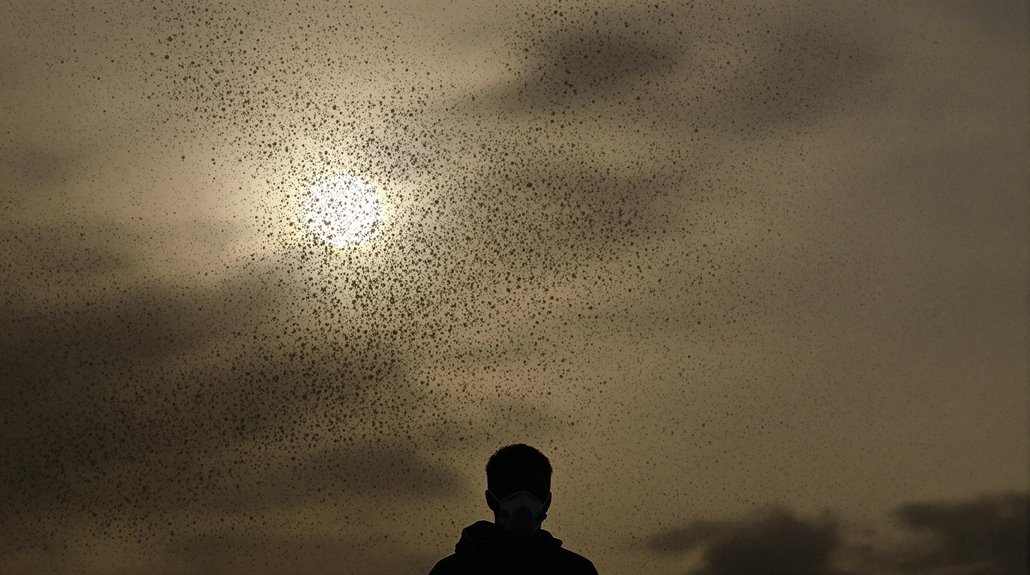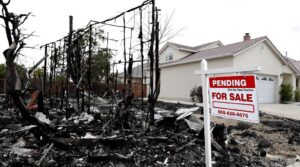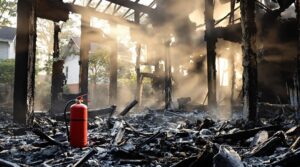Inhaling volcanic ash poses significant dangers due to its composition of fine particles and crystalline silica. These particles can deeply penetrate the pulmonary alveoli, leading to respiratory irritation and increased risk of chronic lung conditions, such as chronic bronchitis and silicosis. Vulnerable groups like children, the elderly, and those with pre-existing conditions face heightened risks, including exacerbated asthma symptoms. Safety measures, such as using respirators and HEPA vacuums, are essential to minimize these health hazards. By exploring further, one may uncover additional insights.
Key Takeaways
- Inhaling volcanic ash can cause respiratory irritation and exacerbate asthma symptoms.
- Fine ash particles can reach pulmonary alveoli, posing significant health risks.
- Chronic exposure to volcanic ash increases the risk of lung diseases, including silicosis.
- Vulnerable populations, like children and the elderly, face higher health risks.
- Long-term exposure is linked to cardiovascular issues, including increased heart attack risk.
Understanding the Composition of Ash
Volcanic ash, a byproduct of explosive eruptions, consists of fine particles with a diameter of less than 2 mm, primarily composed of fragmented volcanic rock. The composition of ash particles varies depending on the volcano type and eruption style, encompassing a range of colors from light grey to black. These particles often contain crystalline silica, a compound known for its potential health risks upon inhalation. The respiratory system is particularly vulnerable, as these minuscule particles can infiltrate deep into the pulmonary alveoli, posing serious risks to respiratory health. While the immediate symptoms may include coughing and throat irritation, the long-term inhalation of such particulates may exacerbate underlying respiratory conditions. Additionally, during ashfall events, the blockage of sunlight can indirectly affect health by impairing visibility, which may complicate emergency response efforts. Understanding these compositional elements is essential for mitigating health risks associated with exposure to volcanic ash.
Health Risks Associated With Inhaling Ash
Inhaling volcanic ash poses considerable health risks, particularly respiratory irritation due to acute exposure, which manifests as nasal and throat irritation and persistent coughing, especially in individuals with underlying pulmonary conditions. Chronic exposure to fine ash particles, which can penetrate deeply into the alveoli, considerably elevates the risk of developing serious pulmonary diseases, with crystalline silica being a notable contributor to chronic respiratory pathologies. Vulnerable populations, including those with pre-existing respiratory disorders and contact lens users, face heightened risks, underscoring the importance of mitigating exposure and implementing protective measures during ashfall events.
Respiratory Irritation Concerns
Although many natural phenomena can impact human health, the inhalation of fine volcanic ash particles presents specific respiratory risks that warrant detailed scrutiny. Respiratory irritation is a prominent concern, particularly affecting vulnerable populations such as children, the elderly, and individuals with asthma. The inhalation of fine ash can exacerbate existing health problems, leading to acute symptoms like nasal irritation, sore throat, and persistent coughing. Medical literature highlights that those with pre-existing lung conditions may experience intensified bronchitic symptoms, including increased sputum production, wheezing, and shortness of breath. During ashfall events, healthcare providers may observe a surge in patients with respiratory complaints, underscoring the need for protective measures. Addressing these concerns is essential in safeguarding public health during volcanic events.
Long-Term Exposure Risks
Addressing the immediate effects of respiratory irritation from volcanic ash is a vital component of public health strategy, but understanding the protracted implications of long-term exposure is equally imperative. Long-term exposure to fine ash, particularly high in crystalline silica, poses significant health hazards, including:
- Lung Disease Risk: Prolonged inhalation can lead to chronic bronchitis and silicosis, conditions characterized by irreversible lung damage.
- Exacerbation of Asthma Symptoms: Individuals with pre-existing conditions like asthma or COPD may face worsened symptoms, leading to increased medical intervention needs.
- Chronic Health Impacts: Communities near active volcanoes experience higher rates of respiratory-related hospital visits, indicating a correlation between ash exposure and chronic health deterioration.
This information underscores the necessity for ongoing health monitoring and protective measures in affected regions.
Vulnerable Populations Impact
Given the increased susceptibility of certain demographics, the impact of inhaling volcanic ash on vulnerable populations warrants thorough examination. Vulnerable populations, such as children, the elderly, and those with pre-existing respiratory conditions, face significant health risks from ash exposure. Fine ash particles, especially those with crystalline silica, exacerbate asthma and can lead to chronic respiratory conditions. Ash exposure triggers respiratory irritation, with acute symptoms like coughing and breathing difficulties more pronounced in children due to their developing lungs and higher respiratory rates. In addition, individuals with weakened immune systems are at risk of severe reactions, including intensified bronchitis symptoms and long-term complications. Emergency reports underscore increased respiratory incidents, advocating for targeted interventions.
| Population Group | Health Risk |
|---|---|
| Children | Asthma exacerbation, lung irritation |
| Elderly | Chronic respiratory issues |
| Pre-existing Conditions | Acute respiratory distress |
| Compromised Immunity | Severe bronchitis, chronic issues |
| General Public | Respiratory irritation |
Impact on Vulnerable Populations

How does the inhalation of volcanic ash affect vulnerable populations? Individuals such as children, the elderly, and those with pre-existing respiratory conditions face heightened health risks. The fine particulate matter in volcanic ash can severely exacerbate respiratory conditions, particularly leading to increased asthma attacks. This results in more frequent hospital visits for those with underlying health conditions due to the adverse health effects.
- Children: They are particularly susceptible to respiratory irritation because their lungs are still developing, and their higher breathing rates increase ash particle inhalation.
- Elderly: This group may experience worsened respiratory and cardiovascular symptoms upon ash exposure, leading to complications and potential hospitalizations.
- Prolonged Exposure: Vulnerable populations in areas with significant ashfall face increased health risks as air quality deteriorates, exacerbating respiratory and cardiovascular issues.
Risks of Structural Ash Contaminants
When examining the risks associated with structural ash contaminants, it is essential to evaluate the presence of hazardous materials such as lead, asbestos, and various toxic substances that become airborne during structural fires. These contaminants pose significant health threats, particularly when fine ash particles are inhaled. Prolonged exposure to these particles can cause respiratory ailments, exacerbate asthma, and lead to severe long-term health issues. Vulnerable populations, including children and individuals with pre-existing respiratory conditions, are at heightened risk. Disturbingly, ash from residential fires is often more perilous than that from wildfires due to the synthetic chemicals in building materials. The inhalation of such ash can cause skin irritation and respiratory distress. Recognizing these health dangers underscores the importance of implementing preventive measures. Understanding the serious implications of exposure to fine ash particles is vital for safeguarding community health and ensuring that those affected are adequately protected from potential harm.
Protective Measures to Minimize Exposure

To mitigate the health risks associated with inhaling ash particles, implementing protective measures is essential. Evidence suggests that individuals, especially those with pre-existing respiratory conditions, can markedly reduce exposure by adhering to recommended guidelines. Protective gear plays a vital role in safeguarding health. Public adjusters' expertise in assessing fire-related damages helps determine the most effective protective measures needed during cleanup and recovery.
- Respirator Use: Utilizing a tight-fitting NIOSH N95 or P100 respirator can considerably decrease the inhalation of harmful particles. These devices are designed to filter out a large percentage of airborne ash, thereby protecting the respiratory system.
- Comprehensive Attire: Wearing gloves, long-sleeved shirts, long pants, and goggles is necessary during ash exposure. This complete coverage prevents skin and eye irritation, which are common health risks associated with ash contact.
- Hygiene and Containment: Immediate washing of skin, eyes, and mouth post-exposure minimizes irritation and contamination. Changing clothing and shoes before leaving the cleanup site further contains ash particles, reducing potential spread and exposure.
Safety Guidelines for Ash Cleanup
Effective ash cleanup necessitates adherence to specific safety guidelines that prioritize the prevention of respiratory and dermal exposure. Protective gear, including gloves, long-sleeved clothing, and goggles, is essential to mitigate the risk of skin irritation and ocular injuries from ash contact. To protect respiratory health, particularly for individuals with pre-existing respiratory conditions, a tight-fitting respirator such as NIOSH N95 or P100 is recommended to filter out fine particles originating from volcanic emissions.
When handling ash, it is vital to prevent airborne dispersion by avoiding dry sweeping. Wetting the ash with water before cleaning reduces particle suspension, thereby minimizing inhalation risks. Additionally, utilizing a HEPA-type vacuum is advised over standard vacuums or leaf blowers, which may exacerbate airborne contamination.
Proper disposal of ash in sealed plastic bags or containers is essential in preventing environmental pollution, as improper disposal can lead to secondary contamination of water systems.
Long-Term Health Implications of Ash Exposure

Inhalation of volcanic ash poses significant long-term health risks, emphasizing the importance of stringent safety measures during cleanup activities. Prolonged exposure to this volcanic hazard, particularly its fine particles and crystalline silica, can lead to severe respiratory conditions. Among these, chronic bronchitis and silicosis are prevalent, with those suffering from pre-existing respiratory conditions, like asthma, being particularly vulnerable. Additionally, the decline in air quality due to ash inhalation has systemic implications, potentially exacerbating heart problems. Studies underscore the increased risk of cardiovascular issues, such as heart attacks and strokes, with continuous exposure.
The cumulative nature of ash exposure means its health effects persist and intensify over time. Consider the following:
- Respiratory Deterioration: Regular exposure can result in chronic respiratory ailments.
- Cardiovascular Risk: Long-term ash inhalation may elevate the risk of heart-related incidents.
- Persistent Symptoms: Symptoms may persist post-exposure, indicating lasting health impacts.
Frequently Asked Questions
What Happens if You Inhale Ash?
Inhaling ash can lead to respiratory issues, with ash particle size affecting penetration depth in lungs. Ash inhalation effects include irritation and increased disease risk. Preventive measures are essential, especially with long-term exposure, to safeguard respiratory health.
What Are the Symptoms of Inhaling Ash?
Symptoms of ash exposure include respiratory issues like nasal irritation, coughing, and shortness of breath. Evidence-based preventive measures emphasize minimizing exposure to reduce health effects, particularly for vulnerable populations with pre-existing conditions such as asthma or bronchitis.
What Does Ash Do to Your Lungs?
How do ash particles impact lung health? Inhalation leads to respiratory effects, including inflammation and irritation. Long-term exposure to fine particles, especially crystalline silica, increases the risk of chronic conditions, necessitating preventive measures to protect vulnerable populations.
Is Ash Toxic to Humans?
Ash toxicity in humans is influenced by its composition, with exposure risks linked to respiratory impact. Chronic inhalation can lead to significant health issues, necessitating adherence to health guidelines to mitigate adverse effects on vulnerable populations.








